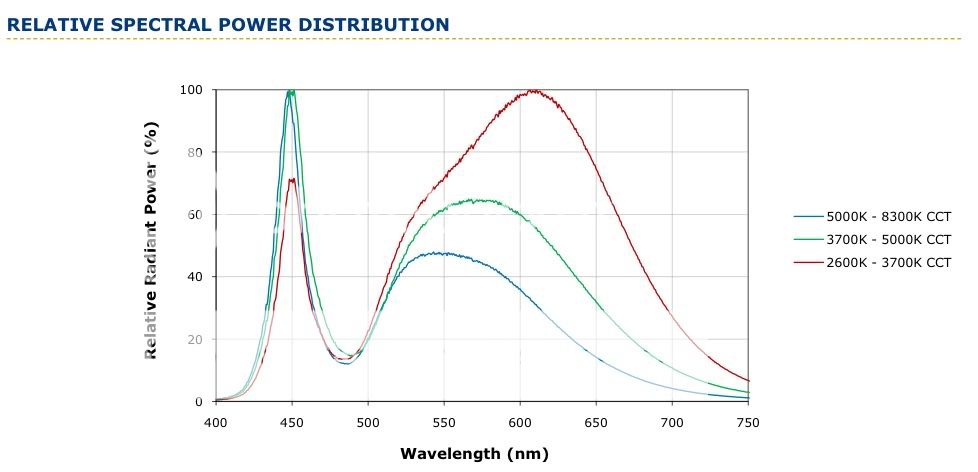garygonzales
Member
yep.... depends if you want the 300 watt which are longer or the 165 watt which are about half the size
yep.... depends if you want the 300 watt which are longer or the 165 watt which are about half the size
you'll be happy either way
Understood. I've seen similar data to that chart before.
But, doesn't white LED, like the replaced 3500K diodes, contain all of those spectrum??? So, why do we need even more of the 420nm or any other blue spectrum? Is there a particular ratio of white:blue that is desirable (for whatever reasons) for reefers?
I'm thinking of replacing those diodes, too, and even a few green and red. But I don't want to go through all that for no reason other than to make the tank look "desirably blue".
White LEDs, with the exception of specialty LEDs such as Philips 'CrispWhite', contain zero violet light.Because along with the 420 spectrum that 3500k has alot of ugly yellow that I don't want.
Because along with the 420 spectrum that 3500k has alot of ugly yellow that I don't want.
Cut both in half and then start from there. Wait until your corals recover, then raise it about 5% weekly or every other week.What do you guys have the power turned to on yours? I m running blues at 100% and white at about 75% but it is bleaching my SPS corals. What should you guys recommend doing ?
Cut both in half and then start from there. Wait until your corals recover, then raise it about 5% weekly or every other week.
White LEDs, with the exception of specialty LEDs such as Philips 'CrispWhite', contain zero violet light.
In addition, it is that 'yellow' light that gives anything that doesn't fluoresce green or red its reflective color. There is a reason you don't see fixtures based on only cool white and royal blue anymore.
'White' light is simply what appears to our eyes, which are very easily fooled, as white. This is why RGB LEDs, which have very small peaks at 450/470nm, 530nm, and 630nm, missing significant spectrum in between, can appear to our eyes as white.Wow, didn't know that.
Do you mind elaborate your statement? I thought all white light sources contain all of the visible color spectrum.
Thanks


'White' light is simply what appears to our eyes, which are very easily fooled, as white. This is why RGB LEDs, which have very small peaks at 450/470nm, 530nm, and 630nm, missing significant spectrum in between, can appear to our eyes as white.
The thin peaks in this image are the LED outputs, the wide peaks at the top are the spectrum our cone receptors see.

Here are Cree white LEDs, 70CRI versions (which is a very poor rating, similar to the LEDs used in this fixture though, so a decent comparison). Essentially zero violet light, especially as far as corals are concerned

You need that extra red/amber/green from the warm white LEDs to keep non-fluorescent corals colorful. Blues, yellows, purples, some reds, they will not look their best without it. Many fixtures add dedicated red and green LEDs, but these do a poor job overall, as corals are more particular about the spectrum they take in and reflect, and in addition they cause color separation ("disco"). Warm white does a much better job. For those in the thread that think their fixture is too 'yellow' (which it is not, but that's a discussion for another time), then replace the red and green LEDs, and possibly some of the cool whites, with royal blue to suit your taste, but leave the warm white in place for best results.

No, it will have no real tangible bearing on growth, only on coloration. The ultra cool white LEDs in the fixture have almost no green or red.Thank you for the explanation.
I also have more questions. From the the last paragraph, are you saying that we can only get the "extra red/amber/green" from 3500K LED's, and not from 12000K LED's? Are you advocating changing any of the LED diodes (in the Marsaqua) for better coral growth, or it's just fine the way it is?
Thanks again
No, it will have no real tangible bearing on growth, only on coloration. The ultra cool white LEDs in the fixture have almost no green or red.
Yeah, in doing that you probably cut the intensity of those LEDs in half since the violet LEDs that fit this package are very low output lolDang, that's not exactly what I wanted to hear.....not after I had just replaced all those 3500K LED's with 410nm, 420nm, and 430-450nm LED's this past weekend. Oh well, back to the drawing board.
Thanks again for your feedback.
Dang, that's not exactly what I wanted to hear.....not after I had just replaced all those 3500K LED's with 410nm, 420nm, and 430-450nm LED's this past weekend. Oh well, back to the drawing board.
Thanks again for your feedback.
id say leave it be for the time being...if you like the look of it....you can always turn up the intensity too....plus it all depends on what you have in your tank too...it should be good...leave it and see what happens ....its your tank,,,
